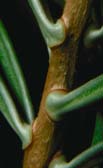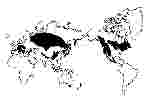Detail of an A. concolor shoot showing leaf structure (white dots are stomata) and leaf attachment to twig [C.J. Earle].
Common Names
Fir, true fir.Taxonomic notes
Linnaeus initially (1753) assigned all firs, spruces and pines to the genus Pinus. Miller forthwith (1754) assigned firs to the genus Abies (type species: A. alba). Various authors have assigned it to ranks above the level of family: Order Abietales Koehne 1893; Family Abietaceae Bercht. & J. Presl 1820; Subfamily Abietoideae Rich. ex Sweet 1826; Tribe Abieteae Rich. ex Dumort. 1827; and Subtribe Abietinae Eichler 1887. The genus has most recently been revised by Liu (7) and Rushforth (8), with a full review of previous classification schemes provided by Farjon and Rushforth (9). The classification used here is almost verbatim from Farjon (6), with minor modifications respecting the Flora of North America (5) and Chinese firs as they are likely to appear in the forthcoming Flora of China. As such, there are a bit more than 50 species. The infrageneric classification is as follows:| SECTION | SUBSECTION | SPECIES | Abies Miller | A. alba (type), A. cephalonica, A. nordmanniana, A. nebrodensis, A. cilicica | Piceaster Spach emend. Farjon et Rushforth | A. pinsapo (type), A. numidica | Bracteata Engelm. emend. Sargent | A. bracteata (type) | Momi Franco (type: A. firma) | Homolepoides (Franco) Farjon et Rushforth | A. homolepis (type), A. recurvata | Firmae (Franco) Farjon et Rushforth | A. firma (type), A. beshanzuensis | Holophyllae Farjon et Rushforth | A. holophylla (type), A. chensiensis, A. pindrow, A. ziyuanensis | Amabilis (Matzenko) Farjon et Rushforth | A. amabilis (type), A. mariesii | Pseudopicea Hickel emend. Farjon et Rushforth (type: A. spectabilis) | Delavayianae Faijon et Rushforth | A. delavayi (type), A. fabri, A. forrestii, A. chengii, A. densa, A. spectabilis, A. fargesii, A. fanjingshanensis, A. yuanbaoshanensis | Squamatae E. Murray | A. squamata (type) | Balsamea Engelm. emend. Farjon et Rushforth (type: A. balsamea) | Laterales Patschke emend. Farjon et Rushforth | A. kawakamii (type), A. balsamea, A. bifolia, A. lasiocarpa, A. sibirica | Medianae Patschke emend. Farjon et Rushforth | A. sachalinensis (type), A. fraseri, A. koreana, A. nephrolepis, A. veitchii | Grandis Engelm. emend. Farjon et Rushforth | A. grandis (type), A. concolor, A. durangensis, A. guatemalensis, A. lowiana | Oiamel Franco (type: A. religiosa) | Religiosae (Matzenko) Farjon et Rushforth | A. religiosa (type), A. vejarii | Hickelianae Farjon et Rushforth | A. hickelii (type) | Nobilis Engelm. | A. procera (type), A. magnfica |
|---|
"In Abies several traditionally accepted species have closely allied sibling species, e.g., A. balsamea-A. fraseri, A. bifolia-A. lasiocarpa, and A. magnifica-A. procera. Other species may be more distinct morphologically, but many of these still appear to have evolved in geographic isolation without strong reproductive barriers developing. Thus, when distributions of species overlap, introgression between the taxa is the rule; this may make it difficult to assign certain individuals to a species" (5). Although this opinion was formulated in regard to certain North American firs, it is exceptionally appropriate to the firs of southwest China, particularly those of subsection Delavayianae. Accurate determination of taxonomic relationships between these species will likely require genetic studies.
Description
Tree: Like most other genera of Pinaceae, species of Abies are typically monoecious evergreen trees with a spire-like or conic crown that often becomes flattened or rounded in old trees. Near the alpine treeline, trees may grow with reduced stature and a contorted growth form, often forming krummholz at the upper limits of tree growth. Their form differs from most genera of Pinaceae in its exceptional uniformity; Abies typically possess a single straight trunk with regularly spaced branch whorls produced at the rate of one whorl per year, so that it is sometimes possible to determine the age of a tree 50 years old simply by counting branch whorls. The branch pattern is also exceptionally regular, with a single terminal and two lateral shoots produced each year at the tip of most active branches. Thus, Abies displays a geometric regularity of form that is only a little less common in Picea and Larix, is rather unusual in Pinus, and is not found in Tsuga.Bark: Smooth and thin on young trees, bearing resin blisters, in age often thick and furrowed or flaking in plates. In most species the bark provides little protection against fire, although a few species are fire-tolerant.
Branches: Whorled, spreading, flattened into a horizontal plane, with irregular internodal branches occasionally produced by epicormic sprouting.
Shoots: Short (spur) shoots are absent. Twigs may be grooved or smooth; prominent leaf scars, circular to broadly elliptic, flush with twig surface, are slightly depressed or slightly raised evenly all around.
Leaves: Borne singly, persisting 5 or more years (maximum 53 years in A. amabilis), spirally arranged but often proximally twisted so as to appear either 1-ranked (pointing up like toothbrush bristles) or 2-ranked, sessile, typically constricted and often twisted above the somewhat broadened base, sheath absent; linear-lanceolate, flat, with two white stomatal bands beneath, keeled below, rounded or notched at the apex, with two resin ducts. Since many species are early seral and form dense stands, there is often a conspicuous structural difference between shade foliage, just described, and sun foliage, growing near the top of the crown in full sunlight. Sun foliage is more or less erect, incurved to nearly falcate, thickened or quadrangular. Buds are ovate or oblong with a rounded or pointed apex; terminal buds are surrounded by 4-5 secondary buds. Cotyledons 4-10.
Cones: Borne on year-old twigs, maturing in 1 season, erect, ovoid to cylindric, generally resinous, dehiscent (falling apart on maturity), cone axis persisting as an erect 'spike' on branch.
Cone scales: Lacking apophysis and umbo, rounded with a hidden or sometime protruding lobed bract (esp. see A. bracteata).
Pollen cones: Axillary, densely clustered along undersides of current year's twigs, globular or conic, appearing in the spring, pendant, yellow to red, green, blue, or purple, leaving gall-like protuberances after falling.
Seeds: Winged, with a resin sac at the wing-seed juncture.
Wood: Lacks resin ducts (1, 3, 8).
x=12 (5).
"Notes on the following features, made at the time of collection of specimens, are useful in identification.
- "Size and placement of resin canals in the leaves as seen in cross section with a hand lens when a leaf is pulled apart or cut with a sharp knife.
- "Stance of the leaves, e.g., whether they are in flat sprays ('2-ranked') or point up like brush bristles ('1-ranked'), and whether some on a twig point in a direction different from others on the same twig.
- "Differences in color and glaucousness of the lower and upper leaf surfaces.
- "Shape of leaf apex as observed with a hand lens.
- "Distribution of stomates - and number of rows of stomates - on the abaxial and adaxial leaf surfaces, particularly midway between base and apex of leaf.
- "Leaf-scar periderm color. Pull a leaf from a twig and note, with a hand lens, the color of the scar's periphery.
- "Presence or absence of resin on the buds (collect a few extra buds for dissection). If buds are not available (as in the early part of the growing season), collect older branch material bearing old bud scales.
- "Cone color of both pollen and seed cones (binoculars are handy to note this feature of the seed cones)" (5).
Range
N America, C America, Europe, N Africa, Asia (S to Himalaya, S China, and Taiwan), i.e., temperate and boreal regions of the northern hemisphere, chiefly in mountainous regions (3). Excepting the two boreal species, A. balsamea (in North America) and A. sibirica (in Eurasia), the genus is confined to mountainous areas in the subtropical and temperate latitudes of the northern hemisphere. Within this realm, its distribution is confined largely according to its ecological requirements and its paleobotanical history.For information on ecological requirements, paleobotany and modern distribution, see (6).
Big Tree
The greatest diameter and stem volume are probably found in A. procera, though greater heights have been reported in A. grandis. The record trees for both species are found in Washington State, in northwest North America.Oldest
Probably A. amabilis. Again, found in Washington State.Dendrochronology
Species of Abies tend to occur on sites with ample moisture and deep soils, where they grow quickly and do not attain great ages. Such conditions characterize closed forest situations, where competition between individuals tends to obscure the effect of large-scale factors, such as climate, on tree growth. Moreover, the tree rings are often difficult to discern and the wood decays quickly after tree death. Consequently, Abies has received relatively little attention in comparison with, say, Pinus or Picea. What work has been done, has largely focused on ecological problems such as stand age structure and forest regeneration after disturbance.Ethnobotany
"North American firs are cut for pulpwood and lumber and, largely from plantations, for Christmas trees. They are also grown as ornamentals. Species of Abies frequently have a pleasant odor; their foliage has been used as a stuffing material for pillows. Most commercial products with "pine odors" are in fact scented with essential oils distilled from Abies foliage by Russian farmers" (5).Observations
Remarks
"Abies" was the Latin name for an Old World species (2).Citations
(1) Silba 1986.(2) Weber 1987.
(3) Li 1975.
(4) Vidakovic 1991.
(5) Richard S. Hunt at the Flora of North America web site.
(6) Farjon 1990.
(7) Liu 1971.
(8) Rushforth, K D. 1987. Conifers. London.
(9) Farjon, A. and K. D. Rushforth (1989). A classification of Abies Miller (Pinaceae). Notes of the Royal Botanic Garden Edinburgh 46 (1): 59-79.
(10) Florin 1963.
back | Abies | Pinaceae | home
This page is from the Gymnosperm Database
URL: http://www.geocities.com/~earlecj/pi/ab/index.htm
Edited by Christopher J. Earle
E-mail:earlecj@earthlink.com
Last modified on 16-Mar-2000

